Billet Bicycle Wheel Q235,Q255,Q275,Q345,3SP,5SP,20MnSi
- Loading Port:
- China main port
- Payment Terms:
- TT OR LC
- Min Order Qty:
- 20 m.t.
- Supply Capability:
- 200000 m.t./month
OKorder Service Pledge
OKorder Financial Service
You Might Also Like
Billet Bicycle Wheel Q235,Q255,Q275,Q345,3SP,5SP,20MnSi
Specification
Steel billet(ingot) by cogging or breakdown of semi-finished products, is the raw material of all kinds of steel mill. Billet section of square, round, flat, rectangular and abnormity of several kinds of, mainly related to the shape of rolled products.
CNBM Q235,Q275,Q345,3SP,5SP,20MnSi Billets Steel
Hot Rolled Steel Billets/ Mild Steel Bar/ Billet Steel
Specification (see below)
Standard: GB/JIS/ASTM
Size: 50*50mm-180*180mm
Length: 3-12mtrs or Customised
Steel material: Q235,Q255,Q275,Q345,3SP,5SP,20MnSi
Technique: Hot rolled
FOB Unit Ton Price $250-350 and Usually I will quote you CFR price.
MOQ: Usually 1000-10000MT/size
Shipment:By Container,Bulk Vessel
Packaging Details: bundles with steel strips or as customers's requirements
Delivery time: Usually within 30 days after the deposit/LC
Inspection:Third party inspection before loading.
Technical data
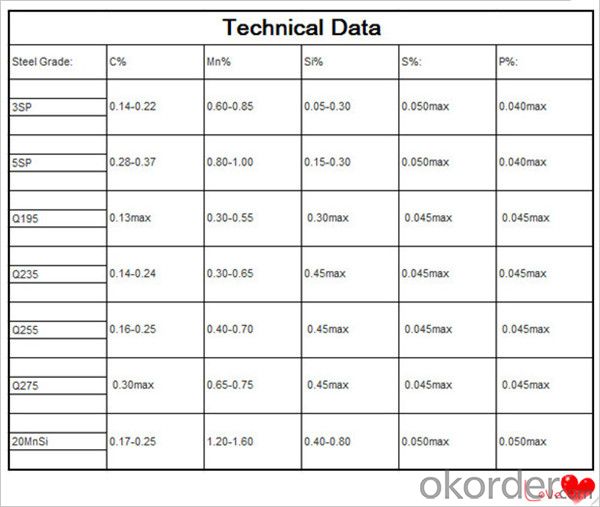
Feature Steel Billet
Rectangular billet continuous casting billet and mainly general carbon steel, low carbon low silicon cold-rolled material, high quality carbon structural steel, high strength low alloy steel, special steel, etc.
The billet is mainly divided into two kinds from the shape:
Slab: cross section width and height of the ratio of the larger, mainly used for rolling plate.
Billet: equal cross section width and height, or a huge difference, mainly used for rolling steel, wire rod. ,
Steel billets have distinct characteristics as compared with already furnished steel bars and products. Billets have a specific grain structure, which enables the metal to be processed more intricately. Steel billets are also known for their malleability and ductility, especially when exposed to varying temperatures during shaping and molding.
Packaging & Shipping
1. Packaging:
1) Small size: in bundles
2)Big size: in bulk
3)in plastic packing or as per customer requirement
2. Delivery time:
1) Normal size: within 7days send from warehouse directly
2) Special size: with 25-30days customer made for you
3. Trade terms:FOB/CFR/CIF
4. Shippment:
1) length:≤5.8m loaded in 20FT Container with 25-27tons
2) length:≤11.8m loaded in 40FT Container with 25-27tons
3) lengnth:≥12m shipped by bulk vessel, FILO terms
Steel Billet Images
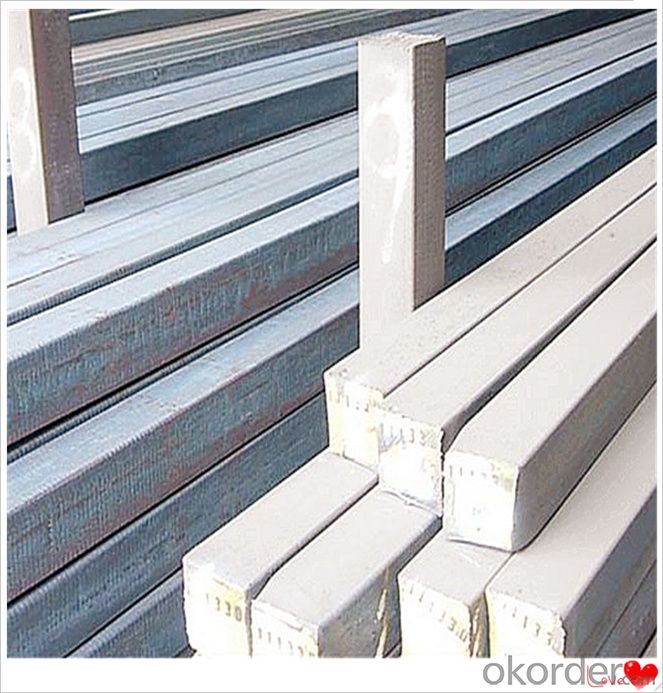
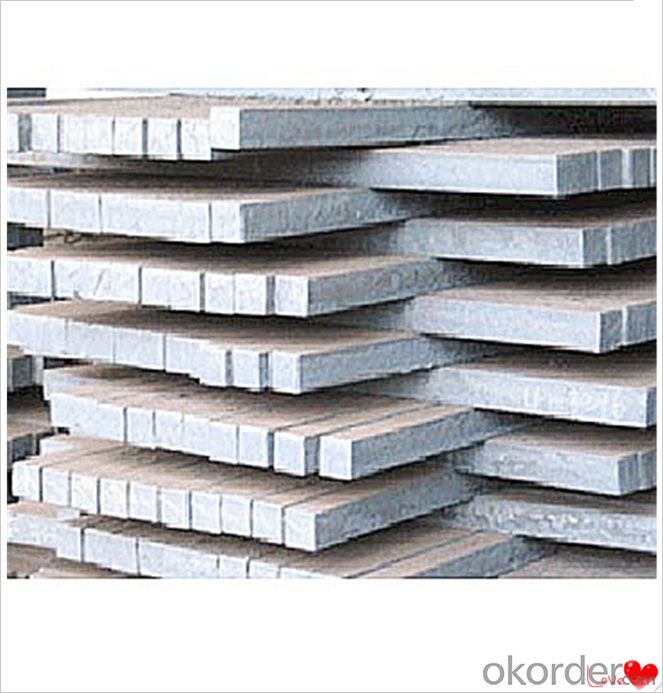
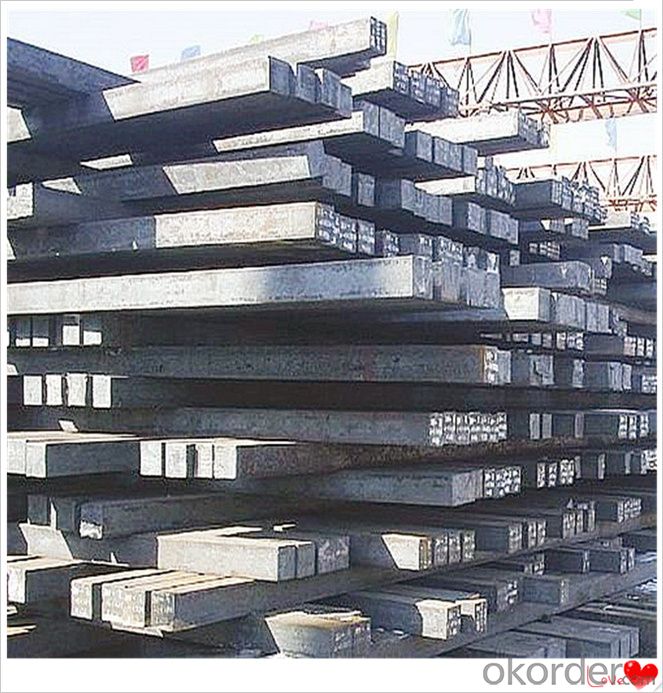

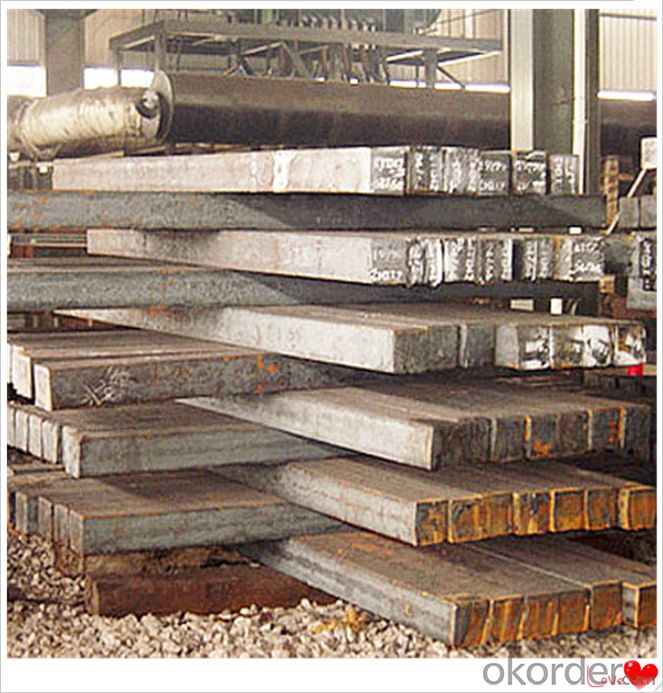
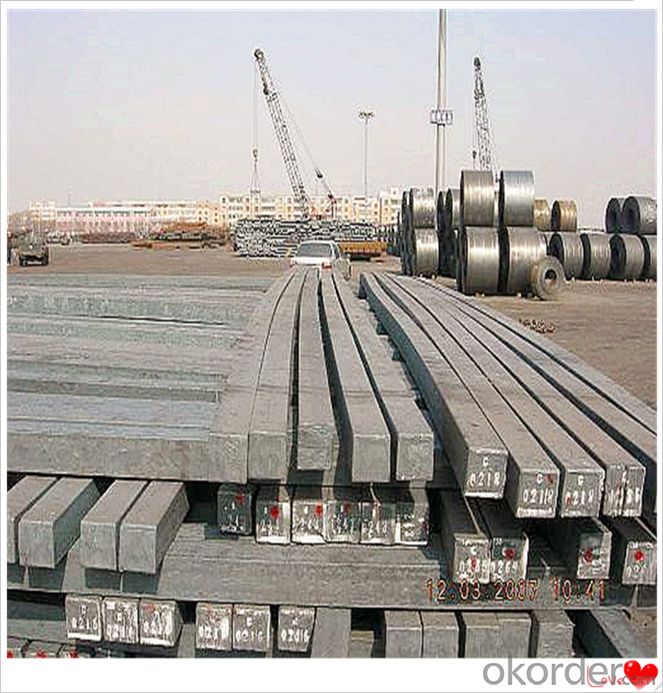
Processing
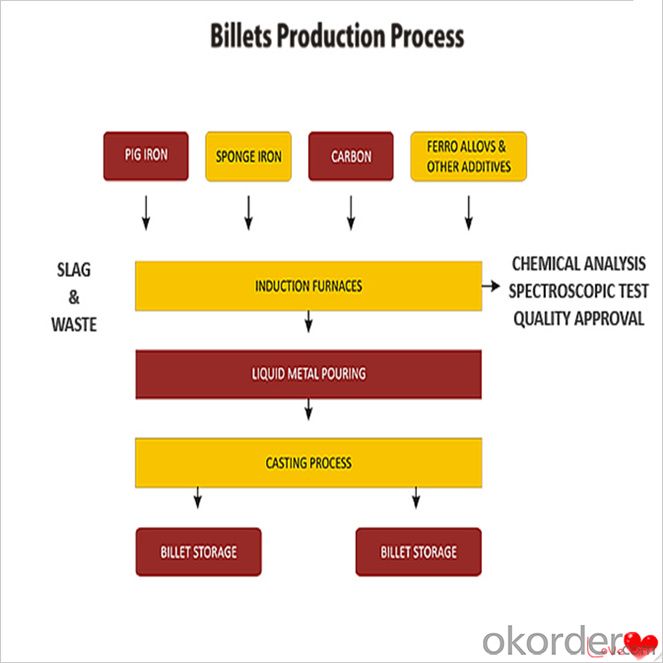
Usage-Billet Steel
Used for the plant, the bridge,shipment building high-rise building construction,lifting and transportation machinery, equipment manufracturing base building the support foundation pile manufacturing.
Billets, or ingots (as they sometimes referred to), are not of practical use until they have been formed into more functional shapes and sizes. While they have already been put in the furnace, they still require a series of shaping and molding procedures such as hot and cold working, milling and cutting before they are sold in hardware stores, or used for different applications. The unformed billets, however, can be used in striking currency such as coins and as reserves, similar to gold bars.
FAQ-Billet Steel
We have organized several common questions for our clients,may help you sincerely:
1) How about your company?
A world class manufacturer & supplier of castings forging in carbon steel and alloy steel,is one of the large-scale professional investment casting production bases in China,consisting of both casting foundry forging and machining factory. Annually more than 8000 tons Precision casting and forging parts are exported to markets in Europe,America and Japan. OEM casting and forging service available according to customer’s requirements.
2) How to guarantee the quality of the products?
We have established the international advanced quality management system,every link from raw material to final product we have strict quality test;We resolutely put an end to unqualified products flowing into the market. At the same time, we will provide necessary follow-up service assurance.
3) How long can we receive the product after purchase?
In the purchase of product within three working days, We will arrange the factory delivery as soon as possible. The pecific time of receiving is related to the state and position of customers.Commonly 7 to 10 working days can be served.
4)Do you have your own QC department?
Yes, we have, our QC department will inspect the goods during the process of mass production and after completion of production.
hot sale!!! Cast Steel Grades/ mild steel bar/ billet steel
(1): High quality steel with reasonable price.
(2): Wide excellent experiences with after-sale service.
(3): Every process will be checked by responsible QC which insures every product's quality.
(4): Professional packing teams which keep every packing safely.
(5): Trial order can be done in one week.
(6): Samples can be provided as your requirements.
- Q:What is the role of steel billets in the construction of offshore platforms?
- Steel billets play a crucial role in the construction of offshore platforms as they are the primary raw material used to fabricate various structural components such as beams, columns, and braces. These billets undergo a series of processes including heating, rolling, and shaping to form the desired structural shapes. Their high strength and durability make them ideal for withstanding the harsh marine environment and supporting the weight of the platform. Ultimately, steel billets serve as the building blocks for offshore platforms, ensuring the structural integrity and safety of these critical structures.
- Q:What are the main factors affecting the wear resistance of steel billets?
- The main factors affecting the wear resistance of steel billets can be categorized into several key aspects. First and foremost, the composition of the steel plays a crucial role. The presence of certain alloying elements, such as chromium, manganese, and molybdenum, significantly enhances the wear resistance of the steel. These elements form carbides and other compounds that create a hard and durable surface, capable of withstanding abrasive forces. Additionally, the microstructure of the steel is vital in determining its wear resistance. Fine-grained steels tend to have better wear resistance as the smaller grain size provides a more uniform and dense structure, reducing the likelihood of cracks and wear. Heat treatment processes, such as quenching and tempering, can be employed to further refine the microstructure and enhance the wear resistance. Surface finish is another vital factor influencing wear resistance. A smooth and well-polished surface reduces the friction between the steel billet and its surroundings, minimizing wear. Various machining techniques, such as grinding and polishing, can be employed to achieve the desired surface finish. Moreover, the hardness of the steel billet is a significant determinant of wear resistance. Hardness is typically measured using the Rockwell or Brinell scales, and higher hardness values generally indicate improved wear resistance. Heat treatment, alloying, and the addition of hardening agents can all contribute to increasing the hardness of the steel billet. Lastly, environmental factors also impact wear resistance. The presence of corrosive substances, high temperatures, or abrasive particles in the working environment can accelerate wear and reduce the lifespan of the steel billet. Employing appropriate coatings, such as chromium plating or thermal spraying, can mitigate these environmental effects and enhance wear resistance.
- Q:What are the main applications of steel billets?
- The main applications of steel billets include the production of various steel products such as bars, rods, wire, pipes, and tubes. They are also commonly used in the automotive, construction, and manufacturing industries for the fabrication of structural components, machinery parts, and reinforcement materials.
- Q:How are steel billets used in the production of construction components?
- Steel billets are an intermediate product used in the production of construction components. They are typically heated and then shaped into various forms such as beams, columns, or rods, which are essential for constructing buildings, bridges, and other structures.
- Q:What are the specifications for stainless steel billets used in the food industry?
- Stainless steel billets used in the food industry have specific specifications to ensure safety and hygiene. These specifications primarily focus on the composition of the stainless steel, its corrosion resistance, and its ability to withstand high temperatures and aggressive cleaning agents. Firstly, the stainless steel used for food industry billets must have a high chromium content, typically ranging from 16% to 18%. This chromium content provides excellent corrosion resistance, preventing the material from reacting with food or cleaning agents. Additionally, these billets should have a low carbon content, usually below 0.08%. Low carbon stainless steel is less prone to sensitization, a process that can lead to corrosion and contamination of food products. Moreover, the stainless steel billets must comply with specific international standards, such as the ASTM A276 or EN 10088, which outline the minimum requirements for chemical composition, mechanical properties, and surface finish. Furthermore, the surface finish of the billets is crucial in the food industry. It must be smooth and free from any defects, such as pits or cracks, to prevent the accumulation of bacteria and facilitate easy cleaning. The dimensions of the billets also play a role in their suitability for the food industry. They are commonly available in square or rectangular shapes, with various sizes depending on the specific application. Lastly, these billets should be certified and compliant with industry regulations, such as those set by the Food and Drug Administration (FDA) or the European Food Safety Authority (EFSA). In summary, stainless steel billets used in the food industry must have a high chromium content, low carbon content, and comply with international standards. They should also possess a smooth surface finish, appropriate dimensions, and meet industry regulations for safety and hygiene.
- Q:What are the factors that affect the mechanical properties of steel billets?
- The mechanical properties of steel billets are influenced by several factors. These factors include the chemical composition, heat treatment, microstructure, grain size, processing conditions, surface condition, and environmental factors. 1. Chemical composition: The mechanical properties of steel billets are determined by the levels of carbon, manganese, silicon, and other alloying elements in the steel. These elements impact the strength, hardness, and ductility of the billets. 2. Heat treatment: By controlling the temperature and duration of heating and cooling, the mechanical properties of steel billets can be significantly altered. Techniques like annealing, quenching, and tempering can enhance the hardness, toughness, and overall strength of the steel. 3. Microstructure: The mechanical properties of steel are greatly influenced by its microstructure, which is determined by factors like cooling rate and alloying elements. Different phases, such as ferrite, pearlite, and martensite, affect the strength, ductility, and toughness of the billets. 4. Grain size: The size and distribution of grains in the steel billets have an impact on their mechanical properties. Finer grain sizes generally result in improved strength and toughness, while larger grain sizes may lead to reduced mechanical properties. 5. Processing conditions: The mechanical properties of steel billets are influenced by the processing conditions during production, such as temperature and rate of deformation. Techniques like rolling, forging, and extrusion affect the grain structure and overall mechanical behavior of the steel. 6. Surface condition: The mechanical properties of steel billets can be significantly affected by the surface condition, including the presence of defects like cracks, voids, or surface contamination. Surface defects act as stress concentration points and reduce the overall strength and integrity of the steel. 7. Environmental factors: The mechanical properties of steel billets can be influenced by environmental conditions like temperature, humidity, and exposure to corrosive substances. Corrosion can decrease strength and structural integrity, while high temperatures can cause softening or thermal degradation of the steel. Considering these factors is crucial in the design and manufacturing of steel billets to ensure that the desired mechanical properties are achieved for specific applications.
- Q:How are steel billets used in the production of oil and gas machinery?
- The production of oil and gas machinery heavily relies on steel billets. These billets are essentially semi-finished pieces of steel that undergo further processing to produce various components needed in the oil and gas industry. To begin with, steel billets are essential in manufacturing the key structural components of oil and gas machinery, such as frames, bases, and casings. These components provide the necessary strength, stability, and support to the equipment, ensuring their safe and efficient operation even in harsh operating conditions. Furthermore, steel billets are also utilized in the production of critical rotating parts, including shafts, gears, and turbines. These components experience high loads, intense pressure, and extreme temperatures, making exceptional strength and durability a requirement. Steel billets, known for their superior mechanical properties, are an ideal material for manufacturing such parts. In addition, steel billets are employed in the production of valves, fittings, and connectors that are integral to oil and gas machinery. These components are responsible for controlling the flow of oil or gas, regulating pressure, and ensuring secure connections between various equipment and pipelines. Steel billets are chosen for these applications due to their excellent corrosion resistance, which is crucial in environments where oil and gas are present. Moreover, steel billets find application in the fabrication of heat exchangers and pressure vessels used in the oil and gas industry. Heat exchangers play a vital role in cooling or heating fluids, while pressure vessels store and transport hazardous substances safely. Steel billets are preferred for these applications due to their high thermal conductivity, excellent weldability, and resistance to extreme pressures. In summary, steel billets are extensively utilized in the production of oil and gas machinery because of their exceptional mechanical properties, corrosion resistance, and thermal conductivity. These billets provide the necessary strength, durability, and reliability to the components and equipment required in the oil and gas industry, ensuring safe and efficient operations in this critical sector.
- Q:Are billet metals within the metal range?
- Two kinds of billets, ferrous, ferrous and metallic, belong to ferrous metal, copper and copper alloy, aluminium and aluminium alloy, and belong to colored metal
- Q:What are the main factors affecting the fatigue strength of steel billets?
- The main factors affecting the fatigue strength of steel billets include the material composition and quality, the presence of surface defects or imperfections, the applied stress levels, the frequency or rate of the applied cyclic loading, and the temperature conditions during the fatigue process.
- Q:Can steel billets be used for making furniture?
- Yes, steel billets can be used for making furniture. Steel billets can be shaped and molded into various furniture components such as frames, legs, supports, and decorative elements. The strength and durability of steel make it a suitable material for furniture that requires stability and longevity. Additionally, steel can be finished with different coatings or finishes to enhance its aesthetic appeal.
1. Manufacturer Overview |
|
|---|---|
| Location | |
| Year Established | |
| Annual Output Value | |
| Main Markets | |
| Company Certifications | |
2. Manufacturer Certificates |
|
|---|---|
| a) Certification Name | |
| Range | |
| Reference | |
| Validity Period | |
3. Manufacturer Capability |
|
|---|---|
| a)Trade Capacity | |
| Nearest Port | |
| Export Percentage | |
| No.of Employees in Trade Department | |
| Language Spoken: | |
| b)Factory Information | |
| Factory Size: | |
| No. of Production Lines | |
| Contract Manufacturing | |
| Product Price Range | |
Send your message to us
Billet Bicycle Wheel Q235,Q255,Q275,Q345,3SP,5SP,20MnSi
- Loading Port:
- China main port
- Payment Terms:
- TT OR LC
- Min Order Qty:
- 20 m.t.
- Supply Capability:
- 200000 m.t./month
OKorder Service Pledge
OKorder Financial Service
Similar products
New products
Hot products
Hot Searches
Related keywords

































